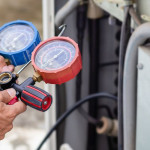Preparing for the Transition to A2L Refrigerants
As the heating, ventilation, and air conditioning (HVAC) industry undergoes one of its most significant transitions in recent history, the shift to A2L refrigerants is becoming a crucial topic for contractors and property owners alike. This change, driven by environmental regulations and the global push to reduce greenhouse gas emissions, represents more than just a simple refrigerant swap. It's a fundamental transformation in the industry’s approach to cooling systems.
These lower-GWP (global warming potential) refrigerants are set to become the new standard in air conditioning systems. This post will explore some basics of the transition to A2L refrigerants, the benefits of A2L refrigerants, and how to prepare for the changes ahead.
What Does This Transition Mean?
The transition to A2L refrigerants represents a significant shift in HVAC and refrigeration technology, driven by environmental regulations and the industry's commitment to reducing global warming potential (GWP). This change means that equipment manufacturers, contractors, and end-users must adapt to new refrigerants that offer better environmental performance while maintaining safety and efficiency. Traditional high-GWP refrigerants are being phased down, with A2L alternatives becoming the new standard for residential and light commercial air conditioning applications.
Traditional refrigerants, while effective for cooling applications, have been identified as significant contributors to global warming due to their high global warming potential (GWP). In response, regulatory bodies worldwide, including the Environmental Protection Agency (EPA) through the American Innovation and Manufacturing (AIM) Act, are mandating the phase-down of high-GWP refrigerants in favor of more environmentally responsible alternatives. A2L refrigerants emerge as a crucial solution in this transition, offering substantially lower GWP values while maintaining efficient cooling performance.
This transition requires substantial adjustments across the industry, including updates to air conditioning manufacturing and installation practices. Technicians will need additional training to safely handle these mildly flammable refrigerants, while manufacturers must redesign equipment to accommodate A2L-specific requirements.
Benefits of Switching to A2L Refrigerants
 A2L refrigerants represent an advancement in cooling technology, offering substantial environmental and performance benefits compared to their predecessors. Most notably, these refrigerants feature dramatically lower global warming potential (GWP) values, reducing climate impact compared to traditional refrigerants. This reduced environmental footprint aligns with global sustainability goals while helping homeowners and businesses comply with evolving regulations without sacrificing cooling performance.
A2L refrigerants represent an advancement in cooling technology, offering substantial environmental and performance benefits compared to their predecessors. Most notably, these refrigerants feature dramatically lower global warming potential (GWP) values, reducing climate impact compared to traditional refrigerants. This reduced environmental footprint aligns with global sustainability goals while helping homeowners and businesses comply with evolving regulations without sacrificing cooling performance.
Beyond their environmental advantages, A2L refrigerants demonstrate superior thermodynamic properties that translate to enhanced system efficiency. These refrigerants typically achieve higher energy efficiency ratios (EER) and coefficient of performance (COP) values, resulting in reduced power consumption and lower operating costs over the AC equipment's lifetime, saving people money on energy bills. The improved heat transfer characteristics of A2L refrigerants also mean that systems can often operate with a smaller refrigerant charge, further reducing both environmental impact and costs. So, the transition to A2L refrigerants can provide long-term benefits in terms of sustainability and energy savings.
Timeline for the Transition to A2L Refrigerants
 The transition to A2L refrigerants follows a strict timeline established by the Environmental Protection Agency (EPA) under the American Innovation and Manufacturing (AIM) Act. As of January 1, 2025, manufacturers must cease production and import of new residential and light commercial air conditioning equipment using traditional high-GWP refrigerants. This marks the beginning of a significant shift toward A2L refrigerants such as R-454B and R-32 in new equipment manufacturing.
The transition to A2L refrigerants follows a strict timeline established by the Environmental Protection Agency (EPA) under the American Innovation and Manufacturing (AIM) Act. As of January 1, 2025, manufacturers must cease production and import of new residential and light commercial air conditioning equipment using traditional high-GWP refrigerants. This marks the beginning of a significant shift toward A2L refrigerants such as R-454B and R-32 in new equipment manufacturing.
For contractors and property owners, it's crucial to understand that while new manufacturing must comply with these regulations, existing inventory of systems made before January 1, 2025, that don’t use A2L refrigerants can still be sold and installed. Existing systems that don’t use A2L refrigerants can also continue to operate and be serviced throughout their operational lifetime. However, when it’s time for a new air conditioner installation, installing a new system that uses A2L refrigerant can be beneficial and comply with new regulations.
About License to Chill
License to Chill is a family-owned and operated company serving the Pompano Beach area. They offer 24/7 support, straightforward pricing, and bilingual technicians. Call them for air conditioning services in Pompano Beach, FL.



